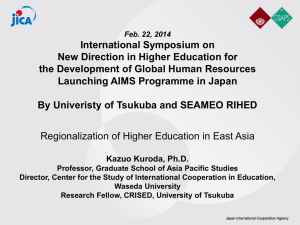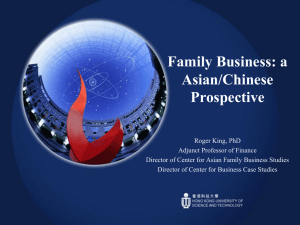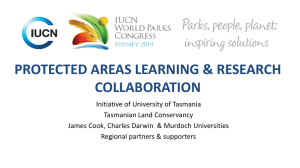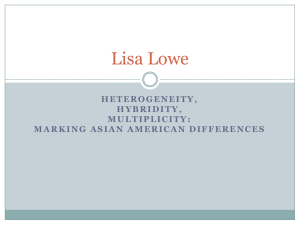Cross-Border Collaborative Degree Programs in East Asia Region
advertisement
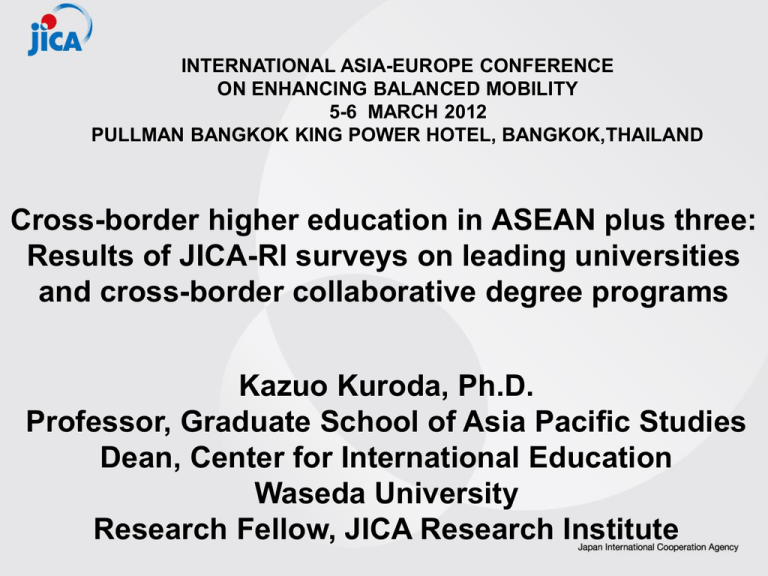
INTERNATIONAL ASIA-EUROPE CONFERENCE ON ENHANCING BALANCED MOBILITY 5-6 MARCH 2012 PULLMAN BANGKOK KING POWER HOTEL, BANGKOK,THAILAND Cross-border higher education in ASEAN plus three: Results of JICA-RI surveys on leading universities and cross-border collaborative degree programs Kazuo Kuroda, Ph.D. Professor, Graduate School of Asia Pacific Studies Dean, Center for International Education Waseda University Research Fellow, JICA Research Institute 1 1. Background Regionalization in East Asia Economic and political integration ASEAN Community Prospect by 2015 Asian Regional Integration Prospect - ”East Asian Summit” started in 2005 by ASEAN+3 (10 ASEAN, China, South Korea, Japan) with Australia, New Zealand and India to discuss a long-term process for the creation of an East Asia Community Hot discussion on TPP Towards integration of higher education Policy discussions on harmonization of higher education in Southeast Asia lead by Southeast Asian Ministers’ Organization/ Regional Centre for Higher Education and Development (SEAMEO/RIHED) and ASEAN University Network (AUN) New Asian regional framework of higher education discussed by ASEAN+3 in Thailand in March 2009 Proposals of “Asian version of ERASMUS” CAMPUS Asia (Collective Action for the Mobility Program of University Students) was just started among China, Korea and Japan in 2011 Inter-regional Cooperation is also in progress.- ASEM 2 Japanese New Educational Cooperation Policy announced by H.E. Mr. Naoto Kan Prime Minister of Japan at the HighLevel Plenary Meeting of the 65th Session of the General Assembly of the United Nations on Sep. 22nd, 2010 - Promote the creation of regional networks in higher education within and among regions in order to address common and similar education challenges by sharing experiences and knowledge of Japan and other countries, with the cooperation of Japanese universities. 3 Background 1. 2. 3. 4. Policy discussions on Asian regional integration and harmonization of higher education in the East Asia region. Innovative forms of CBHE collaborative activities (e.g. double degree programs) are growing rapidly in East Asia. Japanese ODA has also supported a few cases of such innovative programs, which require collaborations by institutions across borders. Yet, limitations of prior research in the East Asia region on this topic: existed, but not covered entire region, or national level survey. 4 JICA Research Institute- Waseda Joint Research Project (2009-2011) on “Political and Economic Implications of Cross-Border Higher Education in the Context of Asian Regional Integration” 5 Research Core Team JICA-RI-Waseda Team SEAMEO/ RIHED Leader: Kuroda & Yuki Advisor/Member: Yoshida & Koda RA: Kang & Hong Consultant Team for Survey and Follow-up: ASIASEED (from Japan) Consultants in Indonesia, Vietnam, Cambodia for Part I Consultant team in Malaysia For Part I &II 6 Overview Structure of the study Overall question: What are political and economic implications of internationalization of higher education in Asia? Three types of surveys: PART 1-1 Leading universities in ASEAN plus 5 (about 300) PART 1-2 Cross-border collaborative degree programs in leading universities (about 1000 programs) (e.g. twinning) PART 1-3 Industry organizations (15 orgs) 7 Overview of the survey for 300 “leading” universities 8 Dataset 1: Institutional-level Survey Target Identify approximately 300 institutions that can be considered as "leading universities" in ASEAN and plus 5 countries, while ensuring representatives from ASEAN countries & avoiding over-representativeness from non-ASEAN. Sample programs are identified as follows: 1st step: we identify universities that appear in any list of 3 university rankings and 8 international (or regional) university organizations‘ memberships ⇒ Applied for 8 ASEAN countries 2nd, identify universities that appear at least twice in the above lists ⇒ Applied for 2 ASEAN countries and China 3rd, identify universities that appear at least three times in the above lists ⇒ Applied for the rest of countries Lastly, added 22 universities suggested by the participants from the Bangkok Workshop. 99 Dataset 1: Institutional-level Country Brunai Darussalam Cambodia Indonesia Laos Malaysia Myanmar Philippines Singapore Thailand Vietnam China Japan Korea Australia New Zealand Total Freq. 0 5 30 0 16 1 8 0 9 14 19 17 4 7 0 130 Response Number of rate (%) Universities 0% 1 83.3% 6 49.2% 61 0.0% 1 57.1% 28 25.0% 4 25.0% 32 0% 9 22.5% 40 100.0% 14 61.3% 31 58.6% 29 44.4% 9 25.0% 28 0% 7 43.3% 300 * May be less due to the effective answer rate by questions Survey for 300 universities Dimension : Regional partnerships North America Central Asia Western Europe Central and Eastern Europe Northeast Asia Arab States South and West Sub Sahara Africa Asia Latin America and Caribbean Southeast Asia Oceania and Pacific 11 11 Preliminary findings Activeness of regional partnerships for overall cross-border activities: Southeast Asia Overall cross-border activities (ASEAN) 4 3.5 3 2.5 Past 2 Present Future 1.5 1 0.5 0 Southeast Northeast Asia Asia Western Europe North Oceania and South and Central and Central Asia Arab States Sub-Sahara Latin America Pacific West Asia Eastern Africa America and Europe Caribbean Highly active: 4, Fairy active: 3, Moderately active: 2, Slightly active: 1, Not active: 0 12 Preliminary findings Activeness of regional partnerships for overall cross-border activities: Northeast Asia Overall cross-border activities (Northeast Asia) 4 3.5 3 2.5 Past 2 Present Future 1.5 1 0.5 0 North Southeast Northeast Western Oceania South and Central and Central AsiaArab States Latin Sub-Sahara America Asia Asia Europe and Pacific West Asia Eastern America Africa Europe and Caribbean Highly active: 4, Fairy active: 3, Moderately active: 2, Slightly active: 1, Not active: 0 13 Our sample programs’ overview : Institutional-level Western Europe is the most active region for SEA cross-border collaborative degree programs. However, SEA prioritizes its own region over Western Europe in the future for “cross-border collaborative degree programs.” Activeness of regional partnerships for “Cross-border collaborative degree program”: SEA & NEA Cross-border collaborative degree programs (NEA) Present Cross-border collaborative degree programs (SEA) Present Future Future 4 4 3.5 3.5 3 3 2.5 2.5 2 2 1.5 1.5 1 1 0.5 0.5 0 0 Western Europe Southeast Oceania and Northeast Asia Pacific Asia North America North America Southeast Asia Western Europe Northeast Oceania and Asia Pacific Highly active: 4, Fairy active: 3, Moderately active: 2, Slightly active: 1, Not active: 0 14 Suggestions for East Asian Regional Framework of Higher Education on intra-sub-regional cooperation 15 First, the finding shows the deeper collaboration related to higher education within each of the sub-regions, Southeast Asia and Northeast Asia. As the findings generally indicate, Southeast Asian universities most prioritize building partnerships with the other universities in their own region, and Northeast Asian universities also place high priority on building partnerships with the other universities in their own region. These findings support the current regional policy directions. Southeast Asia began discussing regionalization in the education sector within its own region with the construction of the ASEAN Socio-Cultural Community, and in 2011, Northeast Asia initiated the creation of the Asian version of ERASMUS, CAMPUS ASIA, within its own region. These ongoing active intra sub-regional collaborations may lead to the development of a concrete regional framework of higher education for both Southeast Asia and Northeast Asia. Suggestions for East Asian Regional Framework of Higher Education on “East Asia” regional cooperation 16 Second, for overall cross-border activities, both Southeast Asia and Northeast Asia highly prioritize each other as partners for their cross-border activities, even compared to their priorities for other parts of Asia and the Pacific. This fact indicates that integrating the two sub-regions may be a functional next step in constructing a regional higher education framework in East Asia. Therefore, with ongoing active partnerships between the two regions, developing a framework that integrates the two sub-regions, often referred to as ASEAN+3, may function as a useful coordinating forum. In the venue of ASEAN+3, the issue of integration (or harmonization) in higher education has not yet been prioritized. Nevertheless, many expect an increase in awareness of the importance of regional integration in the higher education sector among ASEAN+3 countries in the future. Suggestions for East Asian Regional Framework of Higher Education on Inter-regional cooperation 17 Thirdly, although the process of the East Asian regionalization of higher education may begin with an ASEAN+3 structure, it should not end there; rather, it should expand to involve strong complementary relationships with other active regions of partners such as Western Europe and North America considering the perceived importance of these two regions for both Southeast Asia and Northeast Asia. Survey for 1,000 cross-border collaborative degree programs 18 Figure 1. Framework for cross-border higher education (a) Category of mobility (b) Example forms of mobility by “degree of collaboration” between higher education institutions across borders: Low One-side led program People mobility (e.g. students, scholars) Full degree abroad Semester/year abroad Program mobility (e.g. courses, program, degree) Franchised Online/distance Provider mobility (e.g. institutions) Branch campus Virtual university High collaboration Bilateral program Twining** Double/joint degree** Bi-national university Note: * Vertical categories come from Knight while the horizontal column (b) is for this research. Words in Italics are our additions. The underlined forms of mobility are our interests in this paper. 19 **Defined as “cross-border collaborative degree programs” in this paper. Analytical framework Movements (summary of the CBHE framework): Shift (or diversification) from student to program mobility More collaboration between institutions, “collaborative degree programs” Research questions: 1. What do universities expect from “cross-border collaborative degree programs”? How do the expectations differ from “conventional student mobility”? 2. How do these expectations differ within “collaborative degree programs” by degree of collaboration? 3. How about risks? 20 Dataset 2: Program-level Our sample programs from survey on “cross-border collaborative degree programs*” in the “leading” universities in the East Asia, conducted by JICA-RI in 2009/10 (*see next slide for definition) Sample programs are identified as follows: 1st step: Identify all “cross-border degree programs” in 300 leading universities, mainly through: MOE site, if available Key country publication, if available Website of each university’s international office or equivalent Key word search in website of each university (key words such as double/joint, twinning, and sandwich), possibly in English as well as each country language Key word in Google site (with country, university, and program type’s name) 2nd step: Grouping the programs with the certain criteria (e.g. Partner university, major, degree type) 3rd step: Cleaning the indentified program list 21 Our definition of “cross-border collaborative degree programs” “Higher education degree programs, which are institutionally produced or organized with cross-border university partnership by at least two institutions in two countries or more.” This includes, for example, double/joint, twinning, and sandwich programs. This does not include, for example, conventional student exchange programs and branch campus. 22 Our questionnaire to sample programs We sent a questionnaire to 1,048 programs in 300 leading universities via email. Main contents 1) General information of the program Partner region Level of degree Major Duration of programs Number of students Curriculum and teaching staff Finance 2)Expected outcomes & Challenges 23 Our sample programs Full sample: 1,048 programs Subset of sample : 254 programs (who responded to our questionnaire ) (Number of responses as of May, 2010) Full samples (a) Number of Programs Brunei Darussalam Cambodia Indonesia Laos Malaysia Myanmar Philippines Singapore Thailand Vietnam (Sub total of ASEAN) China Japan Korea Australia New Zealand (Sub total of plus 5) Total 24 7 3 133 0 112 1 13 81 72 150 572 157 92 69 154 4 476 1,048 Subset samples (b) Number of Programs (All responses) 0 4 32 0 2 0 0 2 7 85 132 85 26 1 10 0 122 254 Response rate (b/a)% Percent 0% 133% 24% 0% 2% 0% 0% 2% 10% 57% 23% 54% 28% 1% 6% 0% 26% 24% Region of partner university Rank All 1 Western Europe 2 Northeast Asia 3 North America 4 Oceania and Pacific 5 Southeast Asia % 31.3 23.1 20.2 11.4 10.9 Northeast Asia North America Western Europe Northeast Asia Southeast Asia Oceania and Pacific % 28.9 25.8 19.2 17.9 5.4 Southeast Asia % Western Europe 34.1 Northeast Asia 22.4 North America 19.6 Oceania and Pacific 17.5 Southeast Asia 4.0 Oceania and Pacific Northeast Asia Western Europe Southeast Asia North America Central and East Europe Latin America and Caribbean (n= 1,048) Western Europe appears to be the most popular partner region for “cross-border collaborative degree program” for 300 leading universities in the East Asia region. Each sub-region of the East Asia has different preferences on regional partner. 25 % 33.5 32.3 21.5 5.1 1.9 1.9 Activeness of regional partnerships Rank 1 2 3 4 5 6 7 8 9 10 26 Region-region Southeast Asia - Western Europe Northeast Asia - Southeast Asia Southeast Asia - Oceania and Pacific Southeast Asia - North America Northeast Asia - North America Northeast Asia - Western Europe Northeast Asia - Oceania and Pacific Northeast Asia - Northeast Asia Oceania and Pacific - Western Europe Southeast Asia - Southeast Asia 195 185 134 112 92 82 70 61 51 23 % 18.6 17.7 12.8 10.7 8.8 7.8 6.7 5.8 4.9 2.19 (n= 1,048) Country of partner university All Northeast Asia Southeast Asia Oceania and Pacific Rank 1 USA 193 USA 82 Japan 116 China 41 2 France 138 Malaysia 34 USA 105 France 36 3 Japan 122 France 29 Australia 92 Singapore 22 4 Australia 107 UK 25 France 73 Hong Kong 11 5 China 73 China 22 UK 42 Malaysia 9 6 UK 70 Korea 16 Netherlands 26 USA 6 7 Malaysia 52 Australia 15 Germany 21 Denmark 3 8 Germany 33 Hong Kong 13 Belgium 12 Germany 3 9 Netherlands 31 Indonesia 12 Sweden 12 UK 3 10 Singapore 30 Canada 9 China 10 Others** 2 11 Hong Kong 24 Germany 9 Malaysia 9 12 Canada 18 Singapore 8 New Zealand 8 13 Indonesia 18 Japan 6 Canada 7 14 Korea 17 Netherlands 5 Thailand 6 15 Sweden 17 Others* 3 Indonesia 5 * Italy, Russia, Sweden and Taiwan ** Canada, Fiji, Italy, Russia, Sweden, Switzerland and United Arab Emirates (All n= 1,048; Northeast Asia n=318; Southeast Asia n=572; Oceania and Pacific n=158) Overall, the Partnership 27 most popular partner country is USA (18%). among Southeast Asian countries is hard to find. To promote intercultural/ international awareness and understanding To promote global citizenship To meet the demand of global economy To achieve research excellence To promote regional collaboration and identity of Asia To meet the demand of Asian regional economy To improve quality of education To promote national culture and values To meet the demand of your national economy To improve international visibility and reputation of your university To generate revenue for your own institution Regional Economic national Political institutional Academic Global “Expected outcomes” in both datasets 28 “Challenges” in dataset 2 Academic Difficulty of assuring quality Irrelevance of education content Difficulty of employment prospect Lack of accreditation Administrative Insufficient financial resource Insufficient administrative capacities Miscommunication with partner university Difficulty of credit transfer recognition Differences in academic calendars Difficulty of recruiting students Difficulty of resolving language issues Social Inequity of access Brain drain Overuse of English as medium Loss of cultural or national identity 29 (1) “Leading” universities data indicates… The vigor of innovative activities such as “cross-border collaborative degree programs” and “use of ICT for cross-border distance education.” are expected to grow extensively in the future. Active level of cross-border activities for all countries Activeness of cross-border activities 4 3.5 3 2.5 2 Past 1.5 1 Present 0.5 Future 0 International/ cross-border institutional agreement Outgoing mobility opportunities for faculty members Acceptance of foreign students Conventional activities Outgoing mobility opportunities for students Cross-border research collaboration Recruitment of full- Cross-border Use of ICT for time foreign faculty collaborative cross-border members degree programs distance education (e.g. double degree, twinning) Innovative activities Highly active: 4, Fairy active: 3, Moderately active: 2, Slightly active: 1, Not active: 0 30 30 (1) “Leading” universities data indicates… Overall, universities perceive academic and political dimensions of outcomes as more significant than economic dimension. Differ by collaboration? The expectation “to improve quality of education” is slightly higher on program mobility than student mobility. Academic "Expected outcomes" Student mobility Cross-border Acceptance of Outgoing mobilty collaborative foregin students for students degree programs Economic Political To improve quality of education 3.1 3.2 3.6 To achieve research excellence 2.9 3.1 3.2 To promote intercultural/ international awareness 3.3 3.4 3.3 and understanding To promote global citizenship 2.9 2.9 2.9 To promote regional collaboration & identity of 3.1 2.9 2.8 To promote national culture and values 3.1 2.9 2.9 To improve international visibility & reputation of 3.4 3.3 3.4 your university To meet the demand of global economy 2.6 2.6 2.7 To meet the demand of Asian regional economy 2.6 2.6 2.6 To meet the demand of your national economy 2.8 2.7 2.7 To generate revenue for your own institution 2.6 2.0 2.5 4:Highly significant, 3: Fairly significant, 2: Moderately significant, 1:Slightly significant, 0:Not significant. (2) Sample program datasets, overall, indicates Key motivations for East Asian programs are in academic and political dimensions. The most important challenge for East Asian programs appears to be “recruiting students”, followed by “resolving language issues”. Expected outcome Rank 1 Improve international visibility and reputation of your institution 2 Improve quality of education 3 Promote intercultural/international awareness and understanding 4 Meet demand of your national economy 5 Achieve research excellence 6 Promote regional collaboration and identity of Asia 7 Promote global citizenship 8 Meet demand of global economy 9 Meet demand of Asian regional economy 10 Promote nationl culture and values 11 Generete revenue for your own institution Academic dimension Political dimension Economic dimension Mean 3.02 3.00 2.97 2.78 2.69 2.68 2.66 2.63 2.63 2.59 2.08 Rank 1 2 3 4 5 6 7 8 9 10 11 12 13 14 15 Challenges Difficulty of recruiting students Difficulty of resolving language issues Insufficient financial resource Difficulty of assuring quality Diffences in academic calendars Insufficient administrative capacities Difficulty of employment prospect Irrelevance of education content Miscommunication with partner university Lack of accreditation Difficulty of credit transfer recongnition Brain drain Inequity of access Loss of cultural or national identity Overuse of English as medium Administrative dimension Social dimension 32 4:Highly significant, 3: Fairly significant, 2: Moderately significant, 1:Slightly significant, 0:Not significant. Mean 2.11 1.98 1.78 1.77 1.73 1.67 1.59 1.58 1.50 1.47 1.46 1.40 1.37 1.26 1.22 Expected outcomes by home region Overall, key motivations for East Asian programs are in academic and political dimensions. Economic dimension is more significant in Southeast Asian programs than in Northeast Asian programs. ALL Rank 1 2 Expected outcome Improve international visibility and reputation of your institution Mean Improve quality of education 3.00 Promote intercultural/international awareness and understanding Meet demand of your national economy 3 4 3.02 2.97 2.78 Northeast Asia (Japan,Korea, China) Expected outcome Promote intercultural/international awareness and understanding Mean Promote global citizenship 2.60 Improve international visibility and reputation of your institution Promote regional collaboration and identity of Asia 5 Achieve research excellence 2.69 Achieve research excellence 6 Promote regional collaboration and identity of Asia 2.68 7 Promote global citizenship 8 2.77 2.55 2.52 Improve quality of education Improve international visibility and reputation of your institution Meet demand of your national economy Promote intercultural/international awareness and understanding Mean 3.69 3.52 3.35 3.31 Achieve research excellence 3.08 Promote nationl culture and values 2.43 Meet demand of global economy 3.02 2.66 Meet demand of Asian regional economy 2.34 Meet demand of global economy 2.63 Meet demand of global economy 2.32 Meet demand of Asian regional economy Promote regional collaboration and identity of Asia 9 Meet demand of Asian regional economy 2.63 Improve quality of education 2.27 Promote global citizenship 10 Promote nationl culture and values 2.59 2.24 Promote nationl culture and values 2.87 11 Generete revenue for your own institution 2.00 Generete revenue for your own institution Academic dimension 33 2.08 Meet demand of your national economy Generete revenue for your own institution Political dimension 2.43 Southeast Asia (All ASEAN countries) Expected outcome Economic dimension Highly significant:4, Fairly significant:3, Moderately significant: 2, Slightly significant: 1, Not significant :0 2.99 2.98 2.88 2.24 Challenges by home region The most important challenges for East Asian programs appear to be recruiting students and resolving language issues. Both Northeast and Southeast Asian programs are less likely to face risks in social dimensions. Rank Southeast Asia (All ASEAN countries) Northeast Asia (Japan,Korea, China) ALL Mean 2.07 2.19 2.12 2.06 Challenges Difficulty of recruiting students Difficulty of resolving language issues Insufficient financial resource Difficulty of assuring quality Diffences in academic calendars 2.04 Irrelevance of education content 1.46 Miscommunication with partner uni Irrelevance of education content Lack of accreditation Difficulty of assuring quality 1.95 1.93 1.93 1.86 Insufficient administrative capacities Inequity of access Difficulty of employment prospect Miscommunication with partner uni 1.46 1.36 1.33 1.27 1.46 Insufficient financial resource 1.83 Brain drain 1.26 Brain drain 1.40 Loss of cultural or national identity 1.82 1.25 13 Inequity of access 1.37 Brain drain 1.77 Lack of accreditation Difficulty of credit transfer recongnition 14 15 Loss of cultural or national identity Overuse of English as medium 1.26 1.22 Overuse of English as medium Inequity of access 1.74 1.55 Overuse of English as medium Loss of cultural or national identity 0.96 0.96 Mean 2.11 3 4 5 Challenges Difficulty of recruiting students Difficulty of resolving language issues Insufficient financial resource Difficulty of assuring quality Diffences in academic calendars 6 Insufficient administrative capacities 1.67 7 8 9 10 Difficulty of employment prospect Irrelevance of education content Miscommunication with partner univ Lack of accreditation Difficulty of credit transfer recongnition 12 1 2 11 34 Academic dimension Challenges Difficulty of recruiting students Difficulty of resolving language issues Diffences in academic calendars Difficulty of employment prospect Insufficient administrative capacities Difficulty of credit transfer recongnition Mean 2.37 1.59 1.58 1.50 1.47 1.98 1.78 1.77 1.73 Administrative dimension 2.27 Social dimension Highly significant:4, Fairly significant:3, Moderately significant: 2, Slightly significant: 1, Not significant :0 1.95 1.87 1.81 1.53 1.18 Our sample programs’ overview : Program-level Post-graduate level is more popular than the undergraduate level. Both level, social science is the first popular field, and engineering is the 2nd popular. Level of degree Master 43% Bachelor 35% BA&MA 5% Doctoral 5% MA&Dr 2% BA&MA&Dip 1% BA&Dip 1% Diploma 1% MA&Dip 1% BA&MA&Dr 0% Others 0% Missing 6% 100% Major field Master Bachelor 57% 30% Social sciences 13% 28% Engineering 6% 5% Science 5% 3% Health 2% 3% Humanities & Arts 2% 1% Agriculture 2% 1% Education 15% 28% Others 100% 100% 35 Major field by partner region: Southeast Asia Partner region Northeast Asia 61 10 Social sciences Southeast Asia 15 Engineering 54 Science Oceania and Pacific 64 Western Europe Health and welfare Humanities and Arts Agriculture 29 51 27 Education North America 66 0% 36 20% 23 40% 60% Percent (%) 80% Others 100% Major field by partner region: Northeast Asia Partner region Northeast Asia 25 Social sciences 69 Engineering Southeast Asia 47 Oceania and Pacific 27 51 Western Europe Science Health and welfare Humanities and Arts Agriculture 28 53 32 Education Others North America 70 0% 20% 15 40% 60% Percent (%) 37 80% 100% (3) Sample programs separated into 2 groups by “degree of collaboration” How? Based on each of the following three criteria* Table: Number of sample programs by “degree of collaboration” Low * 1st 2nd 3rd Location of study Curriculum provider Degree provider High collaboration One-sided Both-side NA or Missing Total 46 43 92 187 176 145 21 35 17 254 254 254 (*See also Annex 1) Interest Are “expected outcomes” perceived as more significant by both-side partnership programs than by one-sided programs? Are “challenges” perceived as less significant by both-side programs than by one-side partnership programs? 38 Academic & Political dimension of expected outcomes is perceived as more significant by “both-sided partnership program” than by “one-sided program” Location of study Curriculum provider Degree issuer One-sided Both-sided One-sided Both-sided One-sided Both-sided Expected outcome Mean Mean Mean Mean Mean Mean To improve quality of education 2.90 3.13 3.25 3.11 2.98 3.09 To achieve research excellence 2.53 2.82 2.63 2.89 2.56 Location of study To promote intercultural/ international awareness outcome andExpected understanding Curriculum provider < 2.83 Degree issuer One-sided Both-sided One-sided Both-sided One-sided Both-sided 2.58 Mean < 3.16 2.85 Mean Mean 2.78 2.65 2.81 2.55 < 3.17 2.89 3.09 Mean Mean Mean 2.82 2.66 2.72 2.88 2.71 2.71 To promote global citizenship 2.51 To promote regional collaboration and identity of Asia 2.45 To promote national culture and values 2.45 2.70 2.53 2.76 2.67 2.60 To improve international visibility and reputation of your university 3.08 3.11 3.13 3.19 3.05 3.07 < < Note: “>” or “<“ indicates that the difference between Group 1 and Group 2 is statistically significant. ( <0.1) 39 4:Highly significant, 3:Fairly significant, 2:Moderately significant, 1: Slightly significant, 0:Not significant Social & Academic & Administrative dimension of challenges is perceived as more significant by “one-sided program” than “both-side partnership program” Challenges Inequity of access Brain drain Overuse of English as medium Loss of cultural or national identity Difficulty of assuring quality Irrelevance of education content Difficulty of employment prospect Lack of accreditation Insufficient financial resource Insufficient administrative capacities Miscommunication with partner university Difficulty of credit transfer recongnition Diffences in academic calendars Difficulty of recruiting students Difficulty of resolving language issues Location of study Curriculum provider Degree provider One-sided Both-sided One-sided Both-sided One-sided Both-sided Mean Mean Mean Mean Mean Mean 1.60 1.33 1.70 > 1.34 1.58 > 1.27 1.75 > 1.35 1.73 1.40 1.66 > 1.27 1.53 > 1.16 1.53 1.24 1.48 > 1.09 1.58 1.22 1.50 1.28 1.51 > 1.13 2.03 1.75 2.13 > 1.75 2.06 > 1.62 1.68 1.57 1.60 1.67 1.69 1.53 1.48 1.63 1.58 1.62 1.73 1.51 1.58 1.46 1.54 1.52 1.57 1.44 1.95 1.78 1.83 1.90 1.94 1.70 > 2.05 1.60 1.80 1.73 1.94 > 1.51 1.68 1.47 1.55 1.54 1.71 > 1.38 1.80 > 1.40 1.58 1.47 1.69 > 1.35 1.73 1.79 1.63 1.86 1.86 1.71 2.05 2.19 2.23 2.23 2.10 2.19 2.08 1.95 2.13 2.13 1.84 1.87 Note: “>” or “<“ indicates that the difference between Group 1 and Group 2 is statistically significant. ( <0.1) Numbers in bold refer to top 3 expected outcomes by each aspect. 4:Highly significant, 3:Fairly significant, 2:Moderately significant, 1: Slightly significant, 0:Not significant Conclusions “Partnership based program” is more effective than “One side led collaborative program” in cross-border higher education to achieve expected outcomes in various dimensions. “Partnership based program” has less challenges than “One side led collaborative program” in crossborder higher education in various dimensions. → Equal Partnership is the key for success of crossborder collaborative degree programs! 41 Thank you very much! 42
